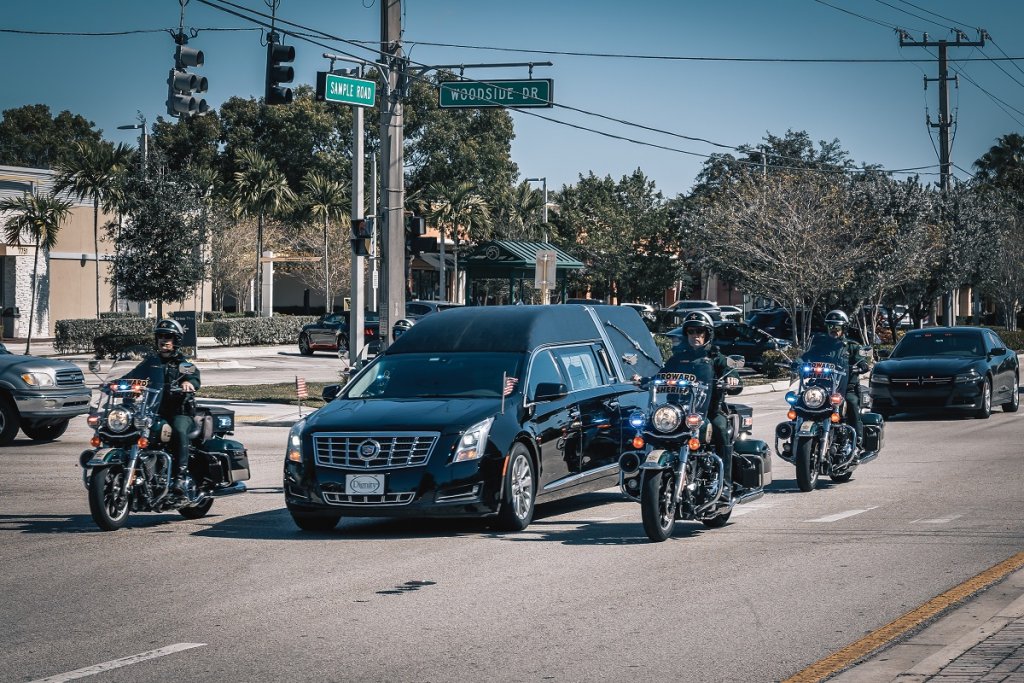Driving in a funeral procession may give several perks to drivers in the line to the cemetery, but it involves following certain rules of funeral procession etiquette as well. Other drivers who encounter a funeral procession must yield the right of way so the procession can stay together.
When you are mourning the death of a loved one, whether you are family or a close friend, it is a challenging emotional experience. Every step of the way will likely be steeped in tradition, and you may be on hand for it all. After the funeral service, you may join the line of cars in the funeral procession to the burial site.
When a body has been cremated, and the remains are to be buried, there may be a procession to the cemetery after the memorial service.
If you plan to be part of the procession, there are some things you need to know.

Table of Contents
Who Participates In The Funeral Procession?
In the most simple of funeral processions, only the hearse carrying the body of the deceased and the immediate family of the deceased will process to the funeral.
In some traditions, anyone who has attended the funeral and wants to become part of a funeral procession to the cemetery is invited to do so. The funeral home provides the hearse, and unless the municipality sends an emergency vehicle to be the lead, the hearse leads the funeral procession. A car filled with immediate family members follows. Sometimes limousines are provided for immediate family, but not always. This is a nice touch if the family is particularly bereaved because it takes the concern of driving off of them.
In the following cars are other family members, with close friends behind those vehicles. Pallbearers should also be among the first set of cars, as it will be their job to help remove the casket from the hearse.
It is important to recognize that in some cultures, only immediate family members are invited to attend the burial. Do not presume that all are welcome. Anytime you attend a significant event like a funeral of someone of a different culture, you should take the time to do some research to be sure you don’t make any social mistakes. The obituary or funeral program may indicate if the burial is private.
Marking The Cars In The Procession
The funeral director or someone else from the funeral home will bring out a flag or other item to mark the cars in a funeral procession. Cars are often marked by a magnetic flag or ribbon tied onto the rearview mirrors.
Cars in a funeral procession also put their hazard lights on as they drive from the memorial service to the final resting place of the deceased. The funeral flags, hazard lights, and slow movement of the procession as people follow the lead car tell others that this is a funeral.
Funerals with a very long funeral procession may not use a funeral flag on every single vehicle; rather, they might tag the first few, then put one on the mirror of every few cars. Sometimes there are double flags on the last vehicle in the procession, or the funeral home might put a tail vehicle to signify to other drivers that the procession has concluded.

Understanding Funeral Procession Etiquette
Funeral home staff may ask if you want to join the funeral procession line. If you do, get your flag and move slowly into the line.
The procession will drive very slowly, and this is for multiple reasons. First, a slow-moving procession makes it much easier for everyone to stay together. Second, processions are meant to mimic the slow march when they were done on foot. Back before motorized vehicles, the officiant and family would walk from the church to the gravesite, with pallbearers carrying the casket. Obviously, this would be a slow and somber process.
Rules Of The Road For Funeral Processions
People often inquire if they have to obey traffic signals, and that depends on the law of the state or area you are in.
In most states, the funeral procession, also known as a cortege, does not have to obey most laws of the road. The lead vehicle will often stop and obey the traffic lights, then continue through.
It is assumed that other vehicles will give right-of-way to cars in a procession. Having said that, always be aware of your surroundings. Just because laws in the state you are in indicate you can go through stop signs does not mean other drivers are adequately watching for you. Be careful!
Since the law is on your side during a funeral procession, you need to be respectful. Drive slowly and carefully, paying attention to other drivers around you. Most processions drive anywhere from 25-35 miles per hour on most roads. On highways, it is okay to speed up, but only if the rest of the procession does so.
There are specific funeral procession laws that your funeral director will be aware of. Motorists in your state should also know them.
What Should Other Drivers Do When Approaching A Funeral Procession?
Rules of etiquette if you encounter a funeral procession that you are not part of require that you:
- Wait until you are certain all cars have passed.
- Pull over to the side of the road and allow them to continue by.
- As a sign of respect, be quiet as the procession passes.
- Never cut into or interrupt the procession. Be certain the entire procession has gone by.
- Know that in most areas, state laws say that those in a procession do not have to obey traffic laws. If the procession has a red light and you have a green, do not go. It is important for the procession to stick together, and in most states, they have the right of way.
- Wait until you see the end vehicle of the procession. Pause a moment before getting behind them.

